Editor’s note: This text-based course is an edited transcript of the webinar, Recycle Bin Boogie – Move and Learn with Recyclables!, presented by Amy Schlessman, BS, MPT, DPT, DHS.
Learning Outcomes
After this course, participants will be able to:
- Describe at least three benefits of physical activity for children and adolescents.
- List at least three general exercise principles for children and adolescents.
- Identify the link between physical activity and learning (including recent research) for children and adolescents.
- Describe at least three creative physical activities that combine academic concepts and recyclables for use in early childhood settings.
Introduction
Today I will be talking about one of my favorite subjects, recycling supplies and how we can take every day common household recycling supplies and utilize those in early childhood to have fun activities that are simple, easy, low budget, and fun. We will talk about how we can easily incorporate those into the classroom, into the home environment for the home-school connection, and utilize them in a variety of early childhood settings.
No matter how long you’ve been working in early childhood, whether you’re brand new or have been doing it for over 20 years, there'll be something for you today in this course. It might be something new that you've never seen before and think, wow that's a really interesting thing I could do with some paper towel tubes, or what a great idea to use with that pizza box or it may be something that you think, I've done something similar to that and this is a new spin on something that has always been a really big hit in my classroom.
If you’ve been doing this for more than 20 years and you've done a lot of things with recycling it could be a way for you to reaffirm some of the things that you're already doing in the classroom and be able to say, "Now I know some of the research behind why children are moving around so much and are so energetic. Now I know that there is research about movement and learning and its benefits, both physically and for academic aptitude.”
Wherever you are in your career, I hope you leave today feeling engaged and empowered with simple activities to take right back to your classroom and your program and to share with others. These activities can be used in any early childhood setting, including in the classroom, in a small group activity, in a large group activity, or even at a tabletop station in dramatic play. There are so many different ways that we can incorporate them into daily activities and share them with parents for home use.
Recycling
Definition
Recycling means to reuse. It means to process items such as metal, paper, glass, and plastics in order to regain material for human use.
Recycling and the School Connection
It’s important for us to teach all of our students, even from a young age, to learn to care for the earth and learn about environmentally-friendly activities such as recycling. Think about that academic link. There are all kinds of activities around recycling that help enhance cognitive development.
- Sorting different types of recycling supplies
- Identifying the relationships of recycling supplies
- Classifying recycling supplies
Not only are children learning about being earth-friendly, but they're also learning about various concepts that tie into academics when discussing recycling supplies.
Youth and Environmental Action
There's a study (Arnold, Cohen, & Warner, 2009) of the perspectives of 12 young environmental leaders and what really influenced them in those formative years. They said that what influenced them was their parents, their friends, their role models, their teachers, early experiences that they had outdoors as a child, youth groups, and going to different gatherings and conferences. All of us here today fall into that role of teacher, role model, and their experiences in childhood. This shows how we tie in and help promote that recycling piece and saving the earth.
A Call to Action: Engage Our Youth
There's a call action to educate our youth from a few different points. There's an urgent action to engage young children as agents of change for the environment, moving education from learning about the environment to educating our children for the environment. There's also a call for more research on young children as agents of change and how we can help promote that from the youngest of ages (Davis, 2009).
Combining Recycling and Physical Activity
Let's talk a little bit about recycling and physical activity and combining those two.
Benefits of Physical Activity
- Improves:
- Participation in activities
- Sense of well-being
- Academic readiness
- Increases and maintains:
- Heart and lung efficiency
- Strength, flexibility, mobility, and coordination
- Bone structure and strength
- Helps control:
- Weight
- Decreases:
- Risks of many chronic diseases (i.e. heart disease, diabetes)
- Anxiety, depression
We'll begin by talking about the benefits of physical activity. According to the CDC, physical activity improves your sense of overall wellness. It also improves academic readiness, which is always a highlighted topic in early childhood. It also improves participation in activities. Physical activity increases and maintains our strength, our flexibility, our mobility, and our coordination. It also increases and maintains our heart and lung efficiency, as well as our bone structure and strength. Physical activity also helps to control weight. It also helps to decrease anxiety, depression, and risk of many chronic diseases, such as heart disease and diabetes.
https://www.cdc.gov/physicalactivity/everyone/health/index.html
Exercise Principles for Children
We're going to talk about exercise principles for children and about how much exercise children are recommended to participate in on a daily basis. For children, it's recommended they get 60 minutes or more of physical activity each day. Within those 60 minutes, three different types of physical activity are recommended: bone strengthening, muscle strengthening, and aerobic activity. https://www.cdc.gov/physicalactivity/everyone/guidelines/children.html
Aerobic activity
- Moderate-intensity aerobic activity
- Brisk walking
- Active recreation (hiking, skateboarding)
- Bicycle riding
- Vigorous-intensity activity
- Active games involving running and chasing, such as tag
- Jumping rope
- Martial arts, such as karate
- Running
- Sports (basketball, swimming, gymnastics)
There are two different types of aerobic activity. There's moderate intensity aerobic activity and there's also vigorous intensity activity. Moderate intensity aerobic activity is recommended daily. This can include brisk walking, bicycle riding, and any type of active recreation, such as hiking, skateboarding, or climbing on various playground equipment.
Vigorous intensity activity is recommended at least three days per week. This would include jumping rope, martial arts such as karate, running, and various sports, such as basketball, gymnastics, and swimming. This would also include all of those active simple games such as running, chasing, and playing tag. More examples of moderate intensity aerobic activity or vigorous intensity can be found at the CDC’s website at https://www.cdc.gov/physicalactivity/everyone/guidelines/children.html.
Muscle strengthening activity
- Games such as tug of war
- Modified push-ups (with knees on the floor)
- Resistance exercises using body weight or resistance bands
- Rope or tree climbing
- Sit-ups
- Swinging on playground equipment/bars
- Gymnastics
The second type of physical activity is muscle strengthening. Muscle strengthening activities are recommended to occur at least three days per week as part of that 60 minutes or more. This could include games of tug of war, which provide resistance using their bodies, or modified push-ups for young children with their knees on the floor. This also includes resistance exercise band activities, rope or tree climbing, sit-ups, swinging on playground equipment, climbing playground equipment, and gymnastics.
Bone strengthening activity
- Games such as hop-scotch
- Hopping, skipping, jumping
- Jumping rope
- Running
- Sports such as gymnastics, basketball, volleyball, tennis
The third type of physical activity is bone strengthening. Bone strengthening, similar to muscle strengthening, is recommended at least three days per week as part of that 60 minutes or more. Some examples of bone strengthening for young children include games such as hop-scotch, hopping, skipping, jumping, jumping rope, and running. Again, sports such as gymnastics and sports with balls including basketball, volleyball, tennis, or any other sport with a ball that involves an activity or game is included here as well. Children may not play the game in the traditional manner or in the early childhood fashion, but again participating with balls and getting that weight-bearing activity is important.
Are Our Children Getting Enough Physical Activity?
Let's take a second to think. Are our children today getting enough physical activity? What we find is no. I want to highlight some of the staggering statistics.
- Obesity is increasing rapidly in the United States, affecting children, adolescents, and adults of all races, ethnicities, and income levels.
- Obese children have a 70% chance of being overweight or obese as adults—facing higher risks for many diseases, such as heart disease, diabetes, stroke, and several types of cancers.
- The costs of treating obesity-related diseases are staggering and rising rapidly.
- In 2004, direct and indirect health costs associated with obesity were $98 billion.
When you think about why are we talking about this in early childhood, I think this is a really important statistic that obese children have a 70% chance of being overweight or obese as adults. Today, many children are inactive and unfit. In the past three decades, childhood obesity has nearly tripled. Seventeen percent of individuals from ages two to 19 are considered obese.
Contributing Factors to Obesity and Overweight
What contributes to this obesity and overweight? It can be due to increases in sedentary lifestyles and decreases in physical activity and physical education as part of the school environment. It also is from inactivity, which cultivates the inactive lifestyle and slower metabolism and increases body fat.
Lack of Physical Activity
Technology can be good, but it also can have its downfalls. What we find is that children ages eight to 18 years of age spend an average of seven and a half hours a day using entertainment media, including TV, computers, video games, cell phones, movies (Rideout, Foehr, & Roberts, 2010). Eighty-three percent of children ages six months to less than six years of age view TV or videos for about 1 hour and 57 minutes a day (Hamel & Rideout, 2006).
A Call for Action
There's a call to action that's recommended from the National Center for Chronic Disease Prevention and Health Promotion that children and adolescents need motivating opportunities to increase physical activity levels through programs at home, school, and in the community. We can help increase the participation in physical activity in both the school and the home. We can help make the home-school connection and provide activities that parents can do at home to help promote this increased activity. I think what's key here is they are saying they need motivating opportunities. What is motivating to children in early childhood?
There's a call to action for schools to have a very important role in increasing physical activity and trying to reverse this obesity epidemic and promote physical activity for children. It is recommended that we do this in a well-coordinated approach to reach children where they live, learn, and play.
Schools can play a critical role in reshaping social and physical environments by providing information, tools, and practical strategies to help children adopt a healthy active lifestyle. Research shows that well-designed, well-implemented school programs can effectively promote physical activity and healthy eating.
Why Combine Learning with Physical Activity? The link between physical activity and learning.
Recent Research
Why should we combine learning with physical activity? A meta-analysis of 59 studies conducted over the course of over 50 years from 1947 to 2009 found that physical activity has a significant and positive effect on academic achievement and cognitive outcomes. Thinking back to the different types of physical exercise we discussed earlier, it found that aerobic exercise had the greatest effect (Fedewa & Ahn, 2011).
Then there was a systematic review of 28 studies, most of which were done between 2010 and 2015. This shows a continuum of research. This systematic review of these 28 studies found the effectiveness of school-based physical activity interventions on both academic achievement and especially on cognitive performance (Mura, Vellante, Nardi, Machado, & Carta, 2015).
In other studies they found that participation in physical activity was associated with increased academic achievement (Castelli, Hillman, Buck, & Erwin 2007; Chomitz, Slining, McGowan, Mitchell, Dawson, & Hacker, 2009; Coe, Pivarnik, Womack, Reeves, & Malina, 2006; Roberts, Freed, & McCarthy, 2010; Singh, Uitjdewilligen, Twisk, van Mechelen, & Chinapaw, 2012; Pontifex, Saliba, Raine, Picchietti,& Hillman, 2013; Lees & Hopkins, 2013; Becker, McClelland, Loprinzi, & Trost, 2014; Ardoy, Fernandez-Rodriguez, Jimenez-Pavon, Castillo, Ruiz, & Ortega, 2014; Esteban-Cornejo, Tejero-Gonzalez, Sallis, & Viega, 2015) and classroom-based high-intensity interval activities improved off-task behavior (Ma, Le Mare, & Gurd, 2014). Some of those higher intensity aerobic activities that we were talking about helped to improve off-task behavior when they tried to redirect students to engage in what they wanted them to engage in.
Overall, research indicates that participating in physical activity increases school achievement, results in better cognitive control and memory task performance, and results in more adaptive and efficient brain function (Chaddock, Voss, & Kramer, 2012; Chaddock, Pontifex, Hillman, & Kramer, 2011). Some people are concerned about adding more physical activity into their classroom. A systematic review of 14 articles was done that resulted in a list of parent perceptions of perceived barriers and facilitators to physical activity for children, especially for children with special needs (Shields, Synnot, & Barr, 2012).
Facilitators included:
- Child's desire to be active
- Practicing skills
- Involvement of the child’s peers
- Family support
- Accessible facilities
- Proximity/location
- Quality opportunities
- Skilled staff to assist them
Barriers included:
- Lack of knowledge and skills
- Child's preferences
- Fear
- Parental behavior
- Negative attitudes towards disability
- Inadequate facilities
- Lack of transportation
- Lack of programs/staff capacity
- Cost
Another interesting research study that I wanted to point out was the role of schools in children's physical activity participation (Huberty, Dinkel, Coleman, Beighle, & Apenteng, 2012). This study looked at the perceptions of the school staff. There was a focus group of 12 elementary schools in the Midwest and they all agreed that physical activity was important. The staff was aware of the benefits of physical activity, however, they noticed that eliminating recess and taking out some of those physical activities during the school day was often used as a punishment for behavior. This should not be the case.
Some of the staff perceptions of barriers to incorporating more physical activity into school included:
- Lack of time due to increasing academic demands (found at all grade levels)
- Peer pressure not to be active (typically found in some of the older students)
- Lack of space
- Lack of equipment
- Staff felt that their encouragement of or active participation in physical activity with children resulted in more activity
There are a couple of key points from recent research I’d like to share. First, school-based physical activity promotion and physical activity opportunities hold great promise for increasing physical activity in children. Second, staff felt that getting training regarding physical activity benefits and research was needed to maximize the efforts in increasing physical activity. The staff's perceptions were, if we know more about the research behind physical activity and how we can include it into the classroom, that's going to maximize our efforts to really do so.
Today we're going to look at strategies that involve some of these barriers. We are going to talk about how to implement physical activity in the classroom while using strategies that involve:
- Minimal planning time
- Minimal space
- Minimal equipment
- Minimal expense
Let's pull it all together.
Safety is a Priority
Safety is always a priority with these activities that we're going to discuss.
- Not all exercise is suitable for everyone. These activities are not intended as a substitute for the specific advice of a physician or a physical therapist. Consulting with a physician or physical therapist prior to beginning any exercise program is recommended.
- Amy Schlessman and Life Fuel (Kid Dynamics LLC) are not responsible for any injury that may occur during any activity as recommended in this course.
- Adult supervision is recommended for all activities in this course. The adult(s) supervising each activity is responsible for determining the skill level and appropriateness of each activity for each child. The adult(s) supervising each activity is also responsible for adapting each activity according to the individual needs of the child(ren).
- Children need to be reminded of safety rules before and during all activities in this course.
Materials
I provided a list of materials for you that will be talked about today. I pulled this list together and I also have this uploaded for you as a separate document as a quick and easy guide. It lists different containers that you may need: two-liter bottles, yogurt containers, drink bottles, plastic lids, milk cartons, different kinds of coffee cans, bottle caps, different types of paper, and then different types of cylindrical containers, mailing tubes, paper towel tubes, wrapping paper tubes and all different types of boxes.
I provided this to you as a separate sheet because this is a great way to tie into your community. You can post the list at the entrance of the school or put it in a newsletter to families to help collect the supplies. It's also a great way to get community involvement. You could reach out to a local club or group (Girl Scouts, Boy Scouts, extracurricular group, sports team) who might be doing a volunteer project. There might be a middle school, high school, or a local business in your area that might want to get involved. I’ve even had different collections from independent living facilities and assisted living facilities. This is a way they can contribute and give back to the community. You could end up getting people of all different ages to help participate in gathering some of the supplies for you.
CONTAINERS
- 2-liter bottles
- Drink and water bottles (all sizes)
- Yogurt containers
- Small plastic tubs and lids (margarine, cottage cheese, sour cream, etc.)
- Large plastic containers and lids (whipped cream, sherbet, ice cream, etc.)
- Milk cartons
- Coffee cans (plastic and metal)
- Bottle caps (milk, sports drinks)
PAPER
- Solid color paper (brown paper grocery bags or construction paper)
- Scrap paper
- Newspaper
CYLINDERS
- Mailing tubes
- Wrapping paper tubes
- Paper towel tubes
- Toilet paper tubes
- Cylindrical containers (oatmeal container, potato chip tube, etc.)
CUBES & RECTANGLES
- Printer paper boxes
- Shoe boxes
- Tissue boxes (cube-shaped and rectangular)
- Cardboard jewelry boxes
- Food boxes (cereal, tea, fruit snacks, granola bars, etc.)
- Pizza box (clean, no grease)
- Toothpaste boxes (small and large)
Activities
Get Organized: Plan Ahead
Let's get organized and plan ahead. We want to make sure we're thinking about gathering some large boxes to collect the recyclable items. The way packages are delivered these days, many things that we want we can order from various services and they are delivered to our doorstep in wonderful boxes. I'm always looking around at my place of employment and where I live and checking out boxes. You want to make sure you're keeping your eyes peeled for great shaped boxes in good condition.
As I mentioned before, this is a great way to plan for parent and community involvement. Send home or post the list of desired recyclable and reusable items for help gathering the supplies. Every time I do this, it happens so fast. People are so willing to help, especially when they know that you're going to be giving items a second life before they are recycled. It's great how individuals get involved. If you are getting people to help, I recommend that you ask them to wash and rinse the recyclables before they give them to you. If not, you will be doing that yourself. Let's go ahead and get started on the activities.
ACTIVITY: Recycling 101
- Materials
- 3 labeled boxes
- 3 items for each student (i.e. plastic, paper, metal, cardboard)
- Describe how and why it is important to recycle
- Describe the types of materials that are recyclable
- Explain and demonstrate sorting of the materials into each box
- Motor: perform a physical activity while traveling to the recycle boxes (i.e. on the way to the boxes
- Walk on a line
- Tiptoe
- Sidestep
- On the way back to their seat: jump, hop, crab crawl
Our first activity is Recycling 101. With this activity, I recommend having three different types of boxes labeled for the three types of recycling you want to sort, for example, paper, plastic, and cardboard. This is just a general sorting project so we can talk about the importance of recycling and the different types of recyclable items. You can explain and talk about how you’re going to sort them and look at the different properties of the items. Then as you go up to those three containers, you can have them do physical activities on the way to those boxes. Sometimes I even recommend four boxes. You could put all the items in one big pile and then have the students run, walk, crawl, or hop to the sorting boxes.
- Number and Number Sense
- Count to 10
- One-to-one correspondence
- Determine “how many” in sets of 5 or fewer objects
- Construct 2 sets of objects, each containing the same number of objects
- Compare sets of equal, more, & fewer; use the language of comparison
With this activity, you can also have them count. Now that you have boxes with the sorted items children can count and do one-to-one correspondence. You can peer into those boxes and count how many objects are in the box if there are sets of five or fewer. You might ask them how many plastic bottles you have and how many cardboard boxes you have. Then with those two sets, we can look and see if we have the same number of objects. You can compare sets of objects and identify if there is an equal number, more, or fewer objects in the sets. We can talk about all that comparative language.
The way I just described is a way to do this activity with a whole class. You can do it at circle time where you're talking about recycling and the students come up and take a turn to put an item in the box. After a group circle time activity, you could put this in a different area of your classroom as an individual activity or a small group activity that students could rotate between and it could be incorporated in that way.
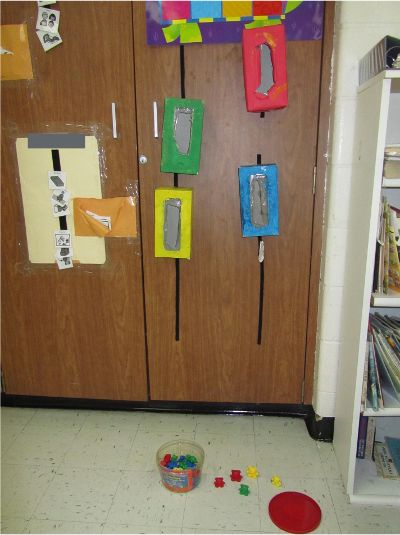
Figure 1. Colored tissue boxes vertically on a cabinet.
If you have limited space a great way to do this is to use cabinets. Figure 1 shows tissue boxes that have been colored attached to the cabinets on a Velcro strip. If you don't have cabinets to put Velcro on, you could use tape on the walls. You could also use a large box and on that large box put Velcro or tape.
One activity you can do is use little plastic bears like these and have the children sort those into the matching color tissue box. Instead of the bears, you could use bottle caps. You’ll want to choose the size of items based on the ages of the children you work with. You could collect different lids, such as margarine and cottage cheese lids or use different types of sports drink bottle lids. You could collect different types of caps of different colors and have them sort the different caps into the different colored boxes.
Instead of going vertically, you could have the boxes on the floor. Children could recreate the large group activity that you used in circle time and do it in a small activity where they go up and they sort them right on the floor into paper and plastic and cardboard.
Children can pick which physical activity they do going up by using homemade dice, which I'll describe a bit later. You can have different physical activities on each side of the dice that they could roll. For example, if they roll and it lands on hop, they would have to get an item and then hop up and circle and drop it in and then the next student could go. This is another great way to take something from circle time and then incorporate that into the classroom and throughout your curriculum.
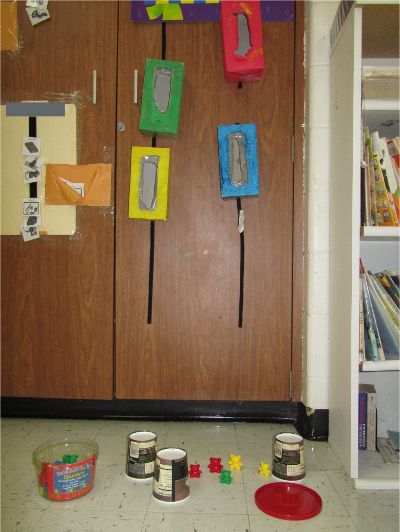
Figure 2. Colored tissue boxes vertically on a cabinet with containers upside down on the floor.
Figure 2 shows another example of how to do this. If you want to make it a little bit more challenging, you could use containers to put these items in and turn them upside down so they have to turn over the container to get the items out. It's just another fun way to find the item if digging in the box may be too easy. This would require that they have to actually bend down, turn the container open, and open the lid and take it off.

Figure 3. Tissue box for storing small items.
In addition, you can have them store the items in tissue boxes because it's a little more difficult to get them in and out of a small slot there. As you can see in figure 3, you could work on fine motor skills by getting the items in and out of a small slot.

Figure 4. Sorting objects in recycled containers.
Figure 4 shows using smaller containers and sorting objects by color or by shape. This could be done on the floor or on a table. Children could sit in different core strengthening sitting positions when doing this on the floor. We've talked about going vertically on the wall or cabinets, on a table, and sitting in different positions on the floor.
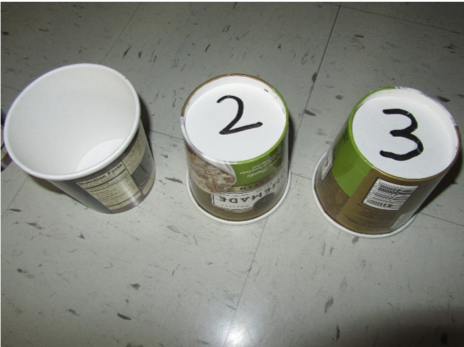
Figure 5. Recycled containers with numbers on the bottom.
Figure 5 shows containers with numbers written on the bottom. You could do this with the actual number or with dots. The dots would help children know how many bottle caps or how many pieces of paper to put in that container. This would help work on the academic piece as well.
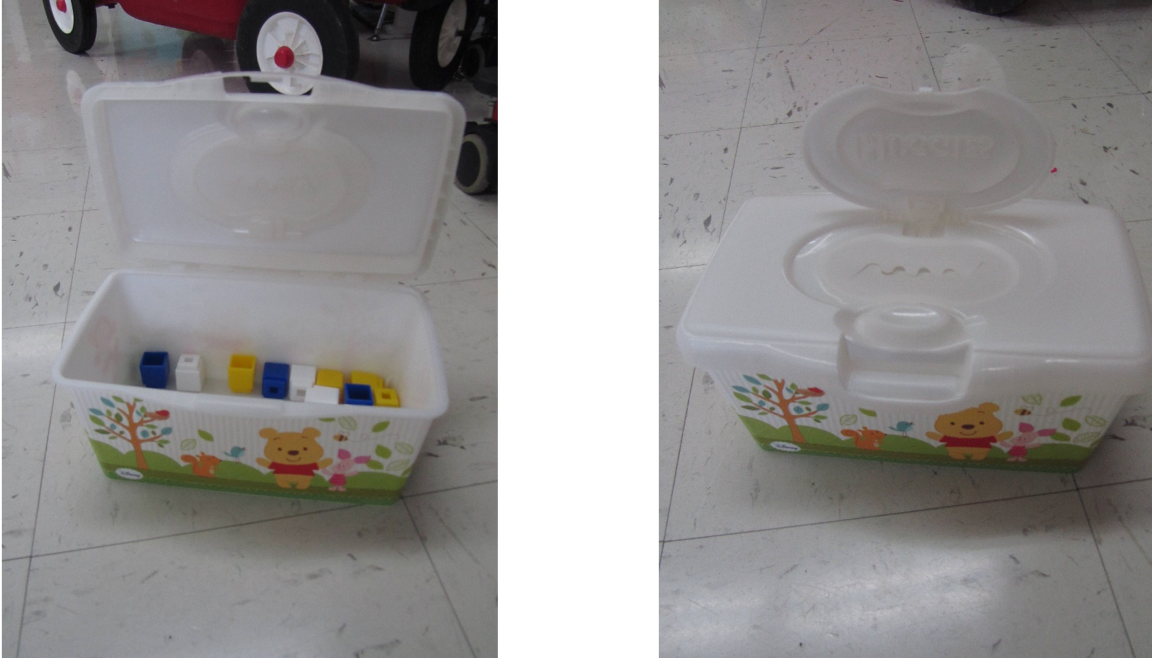
Figure 6. Baby wipe containers for storing small recycling supplies or other objects.
Figure 6 shows baby wipe containers, which are great for helping to store for small recycling supplies, as well as being easily transportable too.
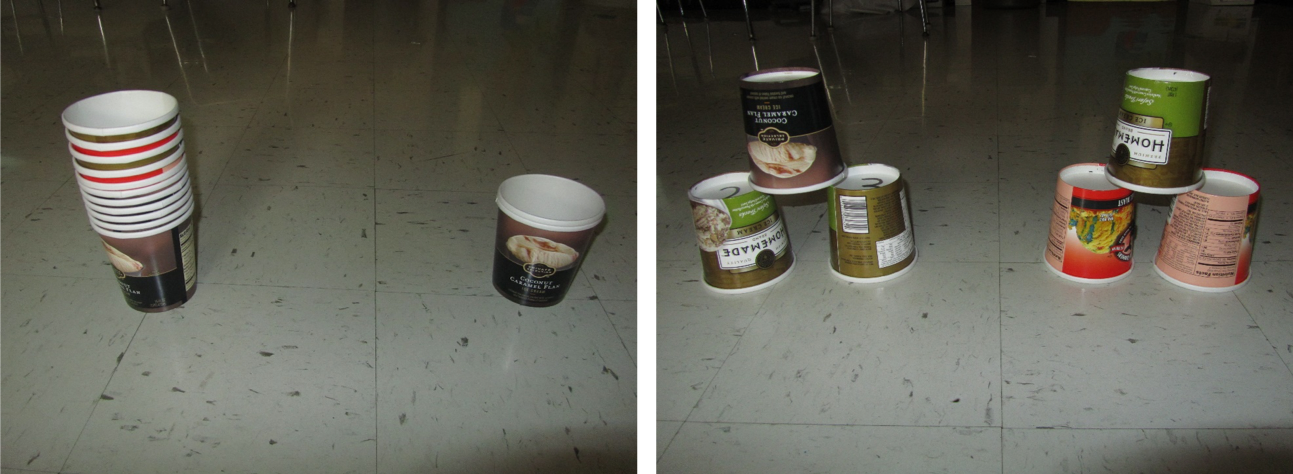
Figure 7. Recycled containers stacked in various ways.
You can also work on the concept of one-to-one correspondence and looking at groupings that are the same, equal, or fewer by just stacking and crashing. What child doesn't like to stack and crash? Have them stack and crash three, then they can make a tower with five. You can script that to the skill you’re working on. They can use different containers. The image on the right side of figure 7 shows a higher skill level of way of stacking versus tissue boxes or little boxes of. You can use number cards or have a dice that they have to roll and pick a number to see how high to stack.
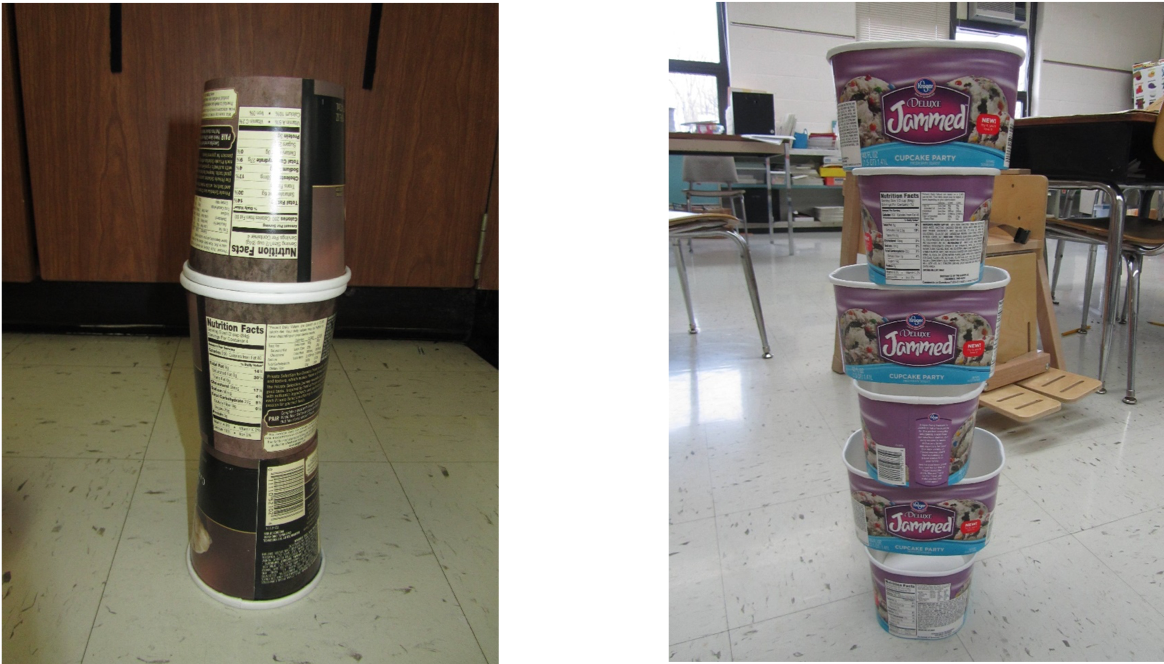
Figure 8. Recycled containers stacked in various ways.
Figure 8 shows additional ways of stacking containers.
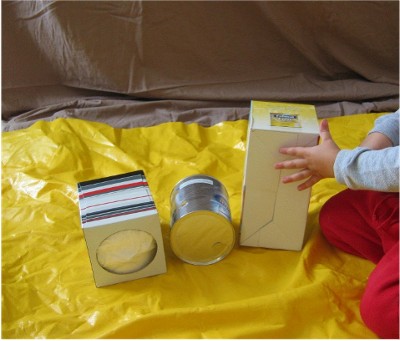
Figure 9. Different shaped recycled containers.
Figure 9 illustrates using various items to talk about measurement, including the different attributes of the different objects.

Figure 10. Ordering a set of objects according to size.
Figure 10 illustrates ordering a set of objects according to size. You can also order objects according to weight or length.

Figure 11. Weighing a recycled box filled with beans.
Figure 11 illustrates a child feeling the weight of a box that’s been filled with beans. You could also put beans or rice in containers and seal them and then have the children figure out which container is heavier or lighter.
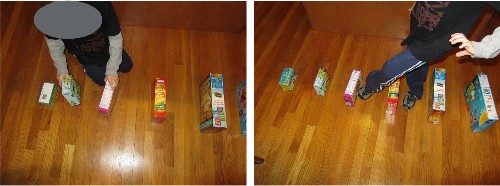
Figure 12. Ordering recycled items from smallest to largest.
Figure 12 shows how items can be placed from smallest to largest and a child can them step over them.

Figure 13. Crashing recycled items like dominoes.
Figure 13 shows how the same objects can be lined up then crashed like dominoes.

Figure 14. Examples of recycling numbers on plastics.
Figure 14 shows various plastic items turned upside down. You can have children look at the recycling number on the bottom and talk about which ones are recycled in your area and which ones are not. Having children squat down and turn the items over if they are on the floor is a great way to increase physical activity.
ACTIVITY: Muscles & Sets
- Construct sets with more or fewer objects than a given set
- Motor
- Lift, carry, & squat to place
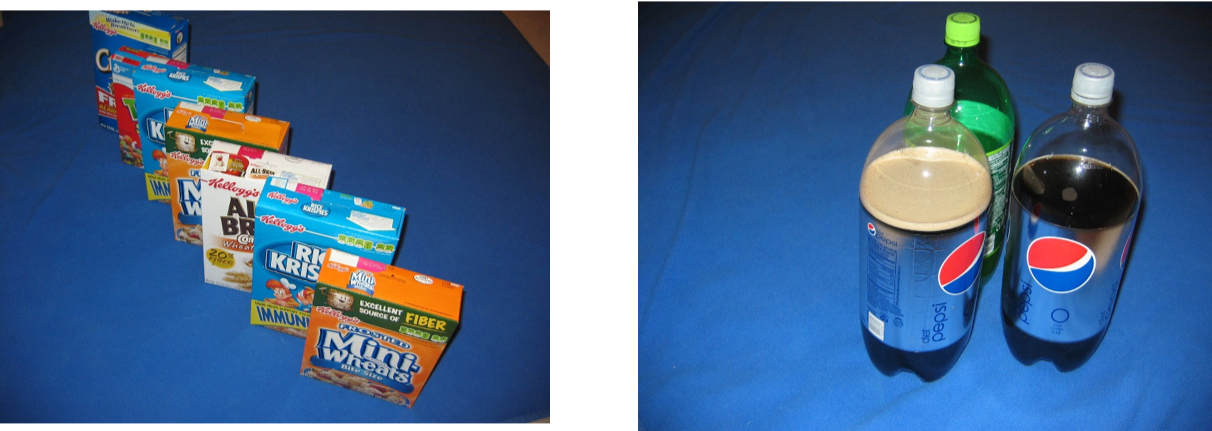
Figure 15. Recycled materials for Muscles & Sets activity.
The next activity is called Muscles & Sets. Figure 15 shows an example of recycled materials you can use. For this activity, you're going to get different objects and have children construct sets of fewer or more than the given set. Then children can lift and see how heavy they are. You might use two-liter bottles or little eight-ounce bottles or 16-ounce bottles and fill them up with different colored water or other liquid with or without glitter and items in them, filling some completely and others with less. You could also fill boxes with other recycling supplies, scraps of paper, or pieces of cardboard that the students cut up. This allows the children to be more actively involved in the activity. They can then decide if the box needs more stuff added to it to make it heavier. This allows you to incorporate science and math concepts into the activity as the children, either in small or large groups, pick up the boxes or bottles and figure out which one is heavier or lighter.
ACTIVITY: What a Combo!!!
- Join 2 sets of objects to make 1 large set
- Use: yogurt containers & small snack items, large boxes, chip cans
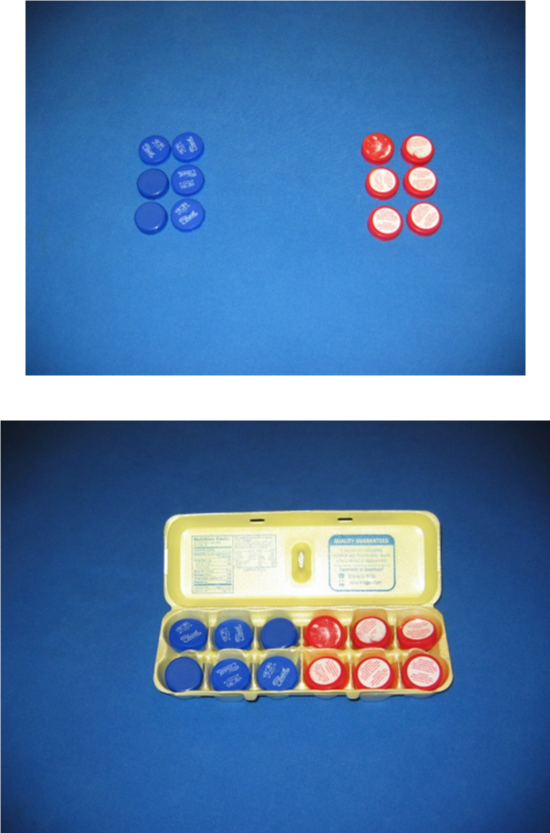
Figure 16. Recycled materials for What a Combo activity.
The next activity is called What A Combo. Figure 16 shows how you can use bottle caps with a container such as an egg carton. If you have a child with an egg allergy, you can use a shoebox lid and then tape smaller boxes inside of it. You could also use tea boxes or small jewelry boxes that you may get and create a compartmentalized box similar to an egg carton. I've even done this with a deeper printer paper box where I'm using different chip cans that are cylindrical to make the different compartments. You can join two sets of objects to make one large set.
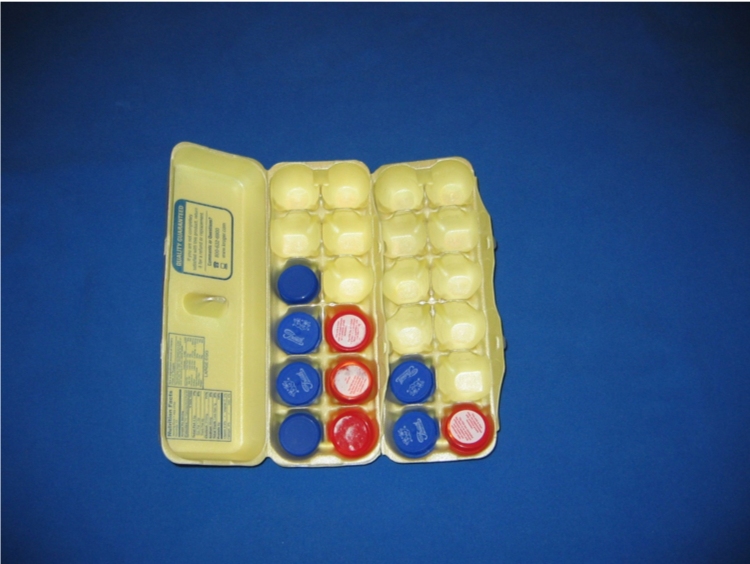
Figure 17. Graphing with caps.
Figure 17 shows how you can do graphing with the same materials. You can graph the bottle caps and look at different attributes. For example, you might say, “Here we have four blue caps and three red caps.” If you have other colors, then you could have two yellow caps and one green cap. The graphing can be done on the floor, on a table, or even vertical on a wall.
When you turn the cap over you can see the twisting component on the inside. Another thing you can do with the caps is to put them on paper or a thicker cardstock and trace them. By tracing the outside of the cap and cutting out what you traced, you can then push that piece of paper or cardstock into the inside of the lid. You can even use some of the recycled materials to trace onto, such as thinner cardboard granola bar boxes, cereal boxes, or boxes that held the individual oatmeal packs. You can write letters or numbers on them or even put pictures of the children inside the lids. The children can then stack and sort the lids by how many boys and girls are in class that day or all the lids of a certain number or shape or dots. The possibilities are endless.
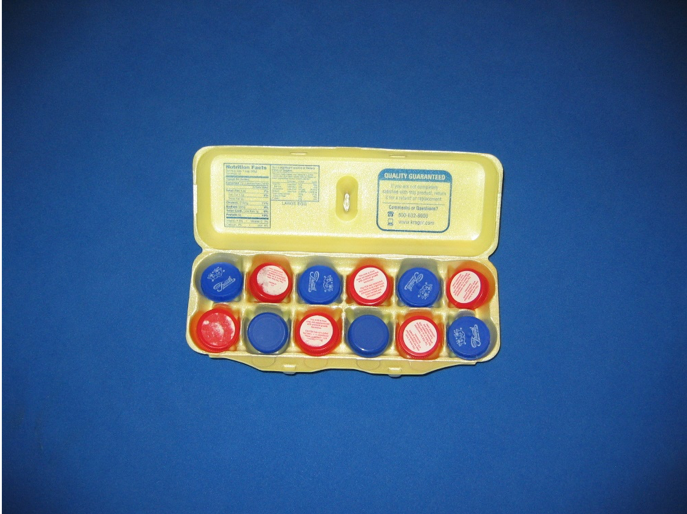
Figure 18. Patterning with caps.
You could also do patterning with this, such as red-blue-red-blue as seen in figure 18. You could have either pictures or words and pattern dog-cat-dog-cat. Again, this could be done on the table or on the floor with a larger box with Pringles cans in it.
ACTIVITY: Lovely Lids
- Equally distribute a set of objects into 2 or more smaller sets (e.g., shares 6 yogurt cups or crackers with 3 friends equally)
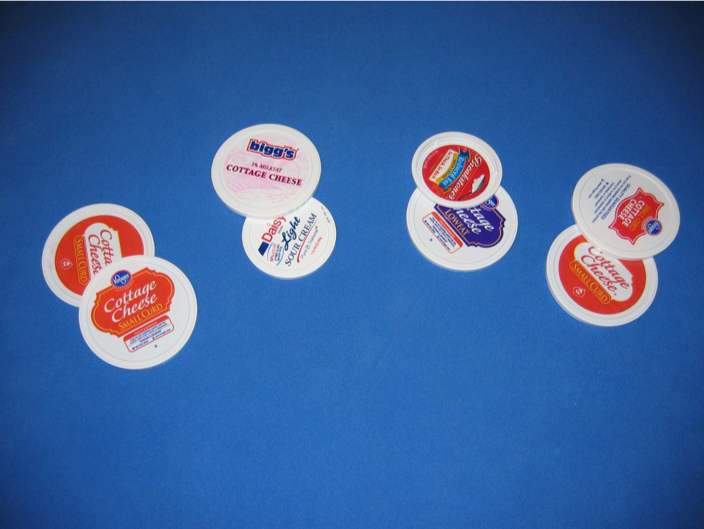
Figure 19. Plastic lids for sorting.
The next activity is called Lovely Lids and involves sorting lids. Figure 19 shows some examples of lids you could use for this activity. You could also use yogurt cups because they stack nicely. You could do this during circle time and pretend that they’re crackers and pretend you’re going to give everybody two “crackers” or lids. The children will equally distribute a set of objects into two or more smaller sets. For example, the child might share six yogurt lids or “crackers” with three friends equally. With this activity, I always think of the book The Doorbell Rang where they have all the cookies and then more and more friends come and they had to give more and more cookies. I like to utilize that book here and then we're continuously dividing the “cookies,” which are the lids or you can use the yogurt cups that have a picture of a cookie inside. They stack very easily and then it's an activity that you can utilize after circle time. This might be in dramatic play or as a tabletop activity. It could be made into a floor activity where you have different people's faces on different placemats and then you can re-create the activity that you did at circle time. This is a great way to start talking about the equal distribution of items with recycling supplies.
ACTIVITY: Simon Says
The next activity is good old Simon Says. You can do this with any recycling supplies you have collected.
- Materials
- Medium size box/container (1 for each student), 3 smaller items (i.e. shoe box, bacon bits container, bottle cap, yogurt container)
- Spatial relationships
- Demonstrate and begin to use the language of the relative position of objects in the environment and play situations (e.g., up, down, over, under, top, bottom, inside, outside, in front, behind, between, next to, right side up, and upside down).
- Step over the box, place bottle cap between your knees, place items inside the box, place your hand next to your box
You could use a little tea box or granola bar box and inside you might have some different little supplies, such as a small cap or a piece of cardboard. Give directions to the children to demonstrate different spatial concepts and positional words. Some examples include:
- Put the bottle cap on top of your head.
- Put the piece of cardboard between your knees.
- Put the piece of cardboard on your back.
- Put the bottle cap on top of your shoe.
- Put the piece of cardboard under your shoe.
Then when you're cleaning up you can use some of the same directions, for example, put the bottle caps inside your box. Children can decorate these however they want and make it their own little Simon Says recycling box. Once you have everything in the box, the students can step over the box or walk around the box. They can take everything out of the box and make it an obstacle where they have to jump over the bottle caps, step over the cardboard piece, and then walk around their individual box. There are many things you could do in a larger small group with Simon Says with recycling supplies.
ACTIVITY: Coin Hokey Pokey
- Students place “coins” or recycle items at their feet
- Sort and classify objects by one or more attributes (e.g., size, shape)

Figure 20. Recycled materials for Coin Hokey Pokey.
The next one is Coin Hokey Pokey. This activity came from a call to action someone gave me when they asked how to teach money with recycling supplies. We attached each of the coins to lids that looked similar to them to have the students recognize coins. For younger children, you can do something similar just with recycling supplies as you see in figure 20.
ACTIVITY: Number Hokey Pokey
- Materials
- Plastic containers with different recycle numbers inside the recycle symbol (i.e. 1, 2, 5, 6)
- Students place “coins” at their feet
- Number and number sense
- Identify and name numerals 0-9
You could do a hokey pokey with just the supplies. You take your cardboard in, you put your cardboard out, you put your cardboard in and you shake it all about. You could also do this with plastic, an aluminum foil piece, or any other recycled item. For an older group of students, you could look at the different numbers on the symbol on the recycling. Put your number two recycling in, your number two recycling out, your number two recycling in, and then shake it all about.
ACTIVITY: Cereal Recall
- Materials
- Empty cereal boxes (8), construction paper, glue, 2 copies of photos or pictures
- Cut out the two largest sides of the cereal boxes
- Glue construction paper to the printed side of the cut-outs
- Glue picture to the construction paper side of each cut-out
- Place the cut-outs on the floor in rows (construction paper side down)
- Students take turns turning over 2 cut-outs at a time, attempting to find the matches
- Geometry and spatial sense
- Match identical two-and three-dimensional objects found in the environment in play situations (e.g. 2 squares of the same size, 2 stop signs)
- Motor
- Walk on a line
- Repetitions of squatting
The next activity is called Cereal Recall. There’s a little play on words there, but this is a fun and safe cereal recall. For this activity, you’ll need some empty cereal boxes you can cut and cover with pictures or photos. You’re going to make a giant game of memory where you’ll put the items in rows on the floor and the children will turn them over.
I’ve done this activity in two different ways. I've done this both flat with just pictures on the cereal boxes and I've also done this in a three-dimensional sense with putting actual three-dimensional recycling supplies on them and then walking in between the different pieces to turn the cards over. This is great for practicing walking on a line, body awareness, body control, squatting, and getting some good core strength as you turn the cards over.

Figure 21. Giant cards from recycled cereal boxes.
I've done this in different ways. Figure 21 shows how you can make this look like giant dominoes. You would put these items on the ground and the students would turn them over, trying to find two like items (sixes, sevens, threes, etc.). When they get two matching items, they pick them up and those are their cards. You could do this and put dots on them or make color cards so they're trying to find two orange cards. If you're talking about community helpers, you could have pictures of community helpers on the pieces of the cereal boxes. The sky's the limit to fit any possible theme. I mentioned the cardboard and bringing those in because you can reuse these pieces. A little tip - if you have the cereal boxes and then you have these different academics, you can change them out with some painter’s tape throughout the year.
ACTIVITY: Monkey See, Monkey Do
- Materials
- Yarn (18 inches), empty toilet paper rolls (2-4 per student), paper, paint, glue
- Prep
- Cut toilet paper rolls into 3 smaller rolls (or cut paper towel rolls into 8 smaller rolls)
- Write numbers 0-9 on rolls
- Create a necklace with the rolls and yarn
- Students stand in a circle and turn music on
- Each student takes a turn standing in the middle of the circle. While in the circle, the student makes up a dance or series of movements and the rest of the class imitates the movements.
- Number and Number Sense
- Represent quantity using invented forms (e.g., child’s marks to represent a quantity of objects)
- Write numerical representations or numerals in a meaningful context
- Identify and name numerals 0-9
- Compare & order whole numbers up to 5
- Motor
- Jump, hop, dance, touch toes, run in place, wave hands above head, wiggle
My next activity is called Monkey See, Monkey Do. I’ve listed toilet paper rolls as the recycled item to use, but some centers don’t want to collect toilet paper rolls. You can use paper towel rolls instead. You can pre-cut them or if you have students who would be safe helping to cut them you can let them cut with you. Either you or the students if they are able, will write the numbers 0-9 on the rolls, each child having their own set. Children will make a necklace using yarn and some of the number rolls.
In a large group, the children will stand in a circle with one student in the middle. Let’s say the student in the middle has a “two” on her necklace. She will sing and do a little dance (or other physical activity) and then the other students will look at their necklaces. If they have a two, then they come to the center and do the same dance and then go back and then a student that has a number three comes in and does a physical activity and then all the number threes come in and do the physical activity. You then later add the whole class doing the physical activity and imitating it too. First the individual child, then his group, then the whole group together.
You could do this with numbers, letters, colors, fruits, or animals to go with your theme. Whatever you're covering academically, it gives a chance for every single student to come in and do a physical activity. If you don't want to set it as open to any physical activity they choose, you could have physical activity cards for them to choose from as well. If every student likes the same physical activity and you want to change it up once that physical activity card is used, you could then put that aside to have them choose other physical activities.
This is another great activity you could do at circle time or put it in your dramatic play area. This could also be done as a tabletop task and have activities that would involve clapping, tapping your head, or holding up two fingers. You could make this more of a fine or a gross motor activity in both a large or a small group.
ACTIVITY: Match It Up
- Materials
- 5’ x 8’ non-skid mat; colored tape; matching pairs of 12-16 recyclable/reusable items
- Prep
- Use tape to make the mat into a grid
- Class surrounds mat, place 1 of each pair in the mat squares, distribute the other items, take turns matching
- Motor
- Squat
- Walk on a line
- Obstacle course (balance and coordination)
- Match identical 2-& 3- dimensional objects found in the environment in play (e.g., 2 squares of the same size, 2 stop signs)
My next one is Match It Up. This is a way to make a matching game and make it three-dimensional. I take a non-skid area rug and divide it up into a grid and we put items on there and then have children sort and match the items.

Figure 22. Homemade grid for Match It Up.
Figure 22 shows a picture of this. I’ve taken a non-skid mat I’ve put a grid on and then I just used some spot markers to give the students a target. I could say, "Ooh, I think the match is on a yellow spot." If you don’t have spot markers you can make some using different colors of non-skid shelf liner.
This could be done as a whole group activity and you can have all the students put one item on each of the squares then give everyone in the class another item. When it's their turn they have to move on the line (walk, jump, tip toe, etc.) to find the match to their item and then squat down and place it on that square. In addition, you could have them do this as an individual or small group activity, where they're putting one item on and then they have to go back and find its match. There are various ways to do the activity and then you could also have them do different action cards as well to get some physical activity in.
You can also do this with smaller recycling supplies as a tabletop task. Again, the sky’s the limit in the different types of supplies that you have. If you're wondering how about sorting this as a smaller group activity, one thing that I do is on each of the different boxes I will put a green strip of painter’s tape and on the other one a blue strip. Let's say one cereal box has a green piece of tape and one has a blue piece of tape. When the activity is over, the students know the green strip goes in the green box and the blue strip goes in the blue box so then everything is sorted, one of each item in each box.
ACTIVITY: How Long?
- Materials
- Recycled items (4 types, 5-10 of each type), colored tape, and ribbon
- Use measurement techniques and tools
- Measure length and volume (capacity) using nonstandard units of measure
The next activity is looking at how long things are and non-standard units of measurement. You can do this with ribbon, colored tape, and different recycling supplies. Ribbon can be reused, but you can also do it with painter’s tape. And set out lines of different lengths.
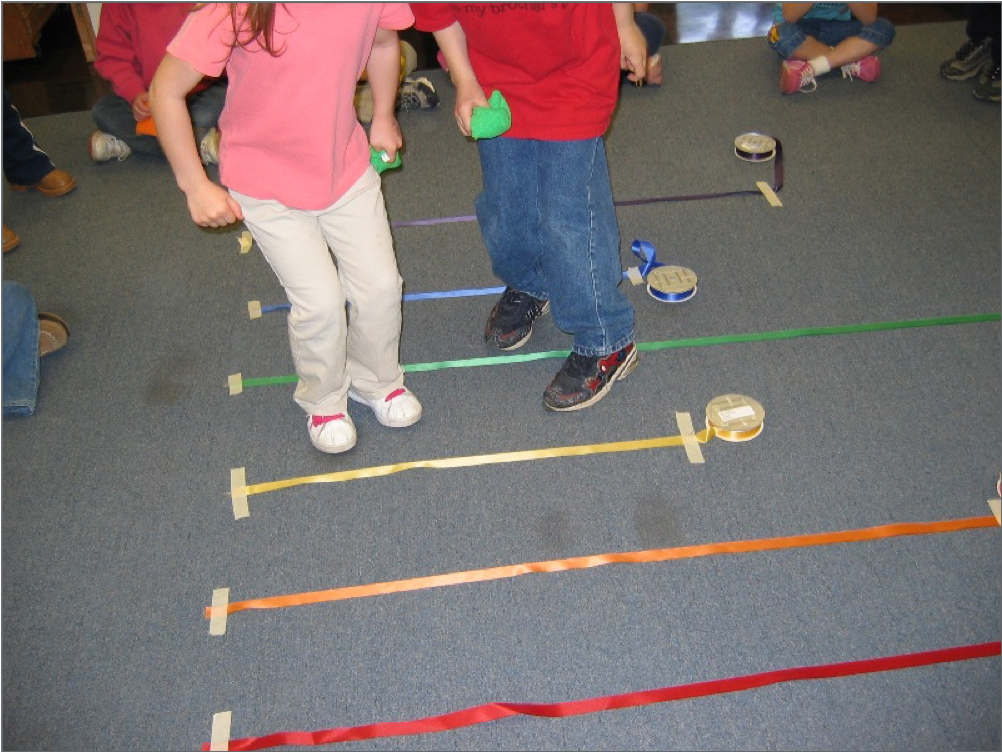
Figure 23. Ribbon placed on the floor for measuring with bean bags.
Figure 23 shows children preparing to measure various lengths of ribbon on the floor, while figure 24 shows a child measuring the ribbon using bean bags.

Figure 24. Children measuring ribbon using bean bags.
You can also use different recycling supplies to measure the ribbon (or tape). One example is to use toothpaste boxes. You can use both small (travel size) and large boxes and ask questions such as:
- How many large toothpaste boxes will cover the red line?
- How many small toothpaste boxes will cover the red line?
- Will we need more of those because they're smaller or the same amount?
You can have children think about and predict how many of those boxes will fit on that line. You can then have them compare and ask, “If the shorter line needs seven toothpaste boxes, about how many will the yellow line need since it’s half the length?”
If you want to go vertical with this, you could put a soft strip of Velcro on the wall or door frame and then some hard Velcro dots on the toothpaste boxes or paper towel tubes and then you can figure out how many go for those lines.
Another really fun one is to add the kids as part of the prediction. You could have a child lay on the ground or stand by that Velcro strip or lie down by the ribbon and then have them figure out, "How many toothpaste boxes long is Amy? "How many toothpaste boxes tall is Amy?" Having students do prediction really helps to engage students. It's a great activity you can do as a small and a large group. Don't forget it's always fun for the children to measure how long the adult is as he or she is laying down.
ACTIVITY: How Does it Move?
- Materials
- Various recycle items, 2-3 large boxes
- Physical sciences:
- Explore & identify parts and wholes of familiar objects (put lids with containers)
- Sort familiar objects by one or more property
- Explore ways of moving objects in different ways (e.g., pushing, pulling, kicking, rolling, throwing, dropping)
How Does it Move? This is a great way for students to figure out how some of these recycling supplies move. You could take different types of recycling supplies and have the students do some predicting and questions such as:
- Would a box roll or would you have to slide the box across the ground?
- Would a two-liter bottle roll or would it slide?
- Could you make it slide? If so, how could you?
- Is this something that you could pull or push or slide?
- Could you kick it?
- Could you roll it?
- Would it drop?
- Would it bounce?
ACTIVITY: Giant Shape Sorter
- Materials
- Large box, recyclable items of various shapes (i.e. rectangles, circles, ovals, square- shampoo bottle, facial tissue box, cereal bar box)
- Prior to class, adult cuts out shapes on all sides of the box to correspond with recyclable items collected
- Place in the block/puzzle area and/or perform as a group activity
- Expansion activity: students decorate the box
- Motor
- Squat
- Tiptoe reach
- Side bend
- Cooperate to dump large box and repeat activity
- Geometry and spatial sense
- Identify, name, create and describe common 2-dimensional shapes
- Identify, name and describe 3-D objects using child’s own vocabulary (e.g., sphere – “ball,” cube – “box,” cylinder – “can” or “tube,” and cone – “ice cream cone”)
One of my absolute favorite activities is a Giant Shape Sorter. Be on the lookout for giant boxes. For this activity, you will need to cut out various holes in a giant box, such as a large circle, a small circle, a rectangle, a square, and a little slot. Then gather different recycling supplies that could fit through those different holes. Have some up high and some down low so the students have to squat and tip toe and side bend to put the different recycling supplies in the holes.
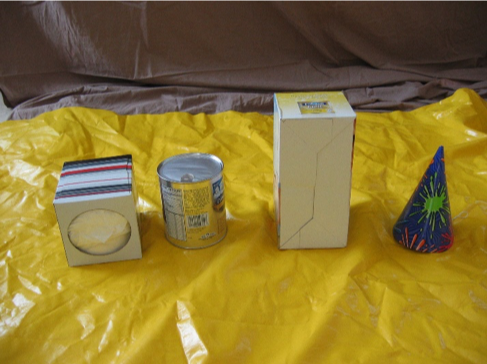
Figure 25. Recycled items of various shapes for Giant Shape Sorter activity.
Figure 25 shows some of the various items children can put into the large box. In this activity, you may be looking at two-dimensional and three-dimensional objects. You might pick up a toothpaste box and say, “Looking at the box this way it looks like a square and could go in the square slot. But if I hold it this way it’s a rectangle and could fit in the rectangle slot.”
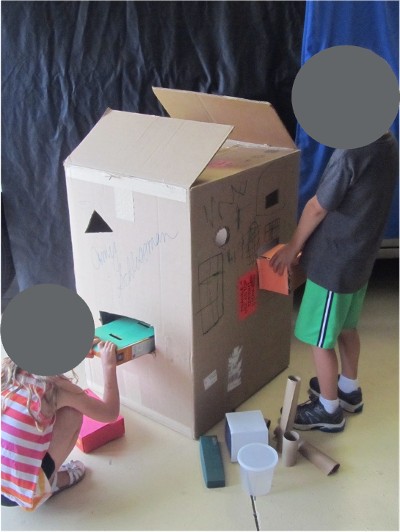
Figure 26. Giant Shape Sorter box.
Figure 26 shows the Giant Shape Sorter and two children putting items in the slots. There's a certain type of chocolate that comes in a triangle-shaped box. I say after this activity, "You will never look at items that come from any store or delivered to your doorstep the same." You'll be constantly looking at different shapes of different containers and the students can then put these in. If you want to up the ante in terms of academics, you could put different academics next to each different shaped hole. For example, a triangle with the letter A by it or a triangle with the number two by it. The children would then have to find the triangle shaped item with a number two on it to go in that hole. This would make it a little more complex and allow you to differentiate your instruction. This can be as simple as matching the shapes or you can increase the academic level. Then, after it's over, dump the box out and do it again. Just as with many of the other activities, this can be an activity that you can do as a part of circle time and then put it out again as a large group activity, or you can make a smaller one as a tabletop fine motor activity.
ACTIVITY: You Can Cones
- Materials
- 2-liter bottles, large coffee cans, milk cartons, colored tape
- Place containers 3 feet apart in a line, use tape on the floor for visual direction
- Tips
- Weigh down the container with water, beans, pebbles, sand, etc.
- Have students help fill the containers
- Math
- Measurement
- Use terms to compare attributes of objects
- Order a set of objects according to size, weight, or length
- Measure volume using nonstandard units of measure
- Physical sciences
- Explore and compare materials with different sensory experiences
- Sort familiar objects by one or more property
- Demonstrate understanding of motion related words
My activity for You Can Cones is a lot of fun as well. For this activity, you will take larger containers such as two-liter bottles, coffee cans, or milk cartons and fill them to be different weights. You can fill them with water, beans, pebbles, or sand. Have the students help fill the containers. You can have them predict how many scoops of the material they need and count as they fill it up. Fill some containers completely and others just a little. I recommend really engaging the children as you make the materials and do the activity because they will be excited about it and go home and talk about what they’ve done. You can send a simple note of how to re-create the activity in a home environment. This is true for many of the activities I’ve talked about.

Figure 27. Obstacle course with recycled materials.
Figure 27 shows an obstacle course created using the containers filled at different weights. You could put the containers from lightest to heaviest and then have them go through an obstacle. For some ages, you could just tell them to zigzag through the obstacle. For younger kids, you may want to use some painter’s tape to have them go through this. You could have them scoot on their bottom, crab crawl, jump, walk, or walk on the line. In a larger area or outside you could have them ride a tricycle through it. There are various ways that you can do this activity, both indoors and out. This is a great way to also include some different sensory experiences in terms of what you're putting inside the containers.
ACTIVITY: Picasso Pizza
- Materials
- Pizza box, paint, paper, small balls (golf, wiffle, marbles)
- Place paper, then paint, then the small balls in the pizza box
- Close the lid
- Work together to move the balls around in the box
- Open the box and view the artwork
- Motor
- Shake it standing up
- Pass it kneeling
- Carry while knee walking
- Tilt it squatting down
- Slide it on the floor
- Forces and motion
- Demonstrate understanding of motion related words (e.g., up, down, fast, slow, rolling, jumping, backward, forward)
- Doing scientific inquiry:
- Predict what will happen next based on previous experiences
- Begin to make comparisons between objects or organisms based on their characteristics

Figure 28. Using a pizza box to make art for Picasso Pizza activity.
Another great activity is Picasso Pizza. For this activity, you're going to use paint and paper and various little recycling items and put them inside a box and shake them to make artwork. You can do this with a shoe box, a pizza box, or a large printer paper box. The bigger the box, the more students you can get shaking and moving that together. Smaller boxes can be more of an individual or a small group activity. Figure 28 shows a child making an individual piece of artwork using a pizza box.
First, put the paper and some squirts of paint in, then put in the items. The items could be lids, paper towel tubes, or small plastic containers. Then have the children shake it while they are standing. You could have them squat and move up and down. They could shake it side to side. You could have them sit on the floor and push it back and forth to each other. This could be done with one of those big pretzel containers or big food containers that are large and clear and has a plastic lid. Children can roll it back and forth to each other on their knees, really moving and shaking that paint around in different physical ways.

Figure 29. Two children using a printer paper box to make artwork.
When you open it up, you have a beautiful picture. Figure 29 shows the result of two children doing this activity. If multiple students are doing this together then you can cut it once it's dry so everyone has a piece of the artwork that they can then put back together and re-create like a puzzle or you can send part of that home for the families to. You can talk about different science topics such as scientific inquiry. You might ask questions such as:
- What's going to happen when we put these different items in?
- Would this one block make more of a thick section of paint?
- What about the bottle caps, are they going to roll?
- What about this item?
You can have children predict what items made which marks in the box as well and then investigate that and talk about the different characteristics or the properties. You can also review how you moved, such as you rolled it, then you slid it, then you shook it. You can talk about different motion-related words as well.
ACTIVITY: Box Car Races
- Materials
- 2 medium size boxes (i.e. shoe box, large facial tissue box, diaper box), construction paper, glue, 2 egg cartons, 24 twist-top plastic bottle caps
- Decorate boxes
- Divide the students into two teams
- Place the egg cartons 5-8 feet from the box cars
- Have a relay race: transport the bottle caps to the egg carton in the box car
- The first team to fill their egg carton wins
- Math
- Use Patterns, Relations, and Functions
- Sort, order, and classify objects by one attribute (e.g, size, color, shape)
- Prediction: is it faster to push the box with your hands or nose?
- Motor
- Move the box car by
- Crawling to push the box with various body parts: hands, foot, elbow, ear, nose
- Running, walking, walk on a line
- 2 students carry box together
- Move the box car by
The next one is Box Car Races and you will need printer-paper size boxes for this activity. Have the students decorate them. If you're doing a transportation theme, it's very fun to have a truck and a car and a train. You can have children then do relay races with this. You can have them do this separately in the printer paper box lids where they're sitting in a lid and pushing themselves. Another option is they can get in a box and have a friend push them, with supervision of course.

Figure 30. Children using printer boxes and lids to have Box Car Races.
Figure 30 shows children moving in various ways in the printer box lids and boxes. In printer box lids, you can move by moving with your hands. You could sit in the box and use your hands and feet, or you could push a friend.

Figure 31. Sorting objects at the end of the Box Car Race.
Then on the way down inside that box children could take a paper towel tube, bottle cap, or some other small item with them to sort at the end. Figure 31 shows a child putting a sticker as a stamp for a giant letter, but you can incorporate it into just sorting the physical properties of recycling supplies or tie it into the theme.

Figure 32. Child's pretend grocery cart used for Box Car Races.
If you're not wanting to use actual students in the boxes, figure 32 shows how you can have them push little grocery carts or push the boxes themselves. Instead of having themselves or a student in it, you could have other recycling supplies in it for the relay race.
ACTIVITY: aMAZE-ing
- Materials
- Yogurt cups, small boxes, drink caps, fruit cups, pizza box, 1 golf ball
- Glue yogurt cups, small boxes, drink caps, and fruit cups inside the pizza box
- Cut a small opening on two opposite sides of the box
- Place the golf ball at one opening
- Work together to move the ball through the maze to the other opening by tipping and tilting the box
- Geometry and Spatial Sense
- Identify, name, and describe three-dimensional objects using the child’s own vocabulary
- Motor
- Work the ball through the maze while standing up, kneeling, half kneeling, squatting, on all 4s
The next one is called aMAZE-ing and you're basically making a maze inside a box with various recycling supplies. You can talk about the different properties of the boxes and then you can move and shake an item.

Figure 33. A maze made from a pizza box and other recycled materials.
Figure 33 shows how we used a pizza box. You can also do this in a large box as well. You just have to make a slot for the cap to enter and a slot for the cap to exit. The red cap at the top of the picture on the left of figure 28 is going to move through the maze and come out the other side. You can have a box for it to drop into. You can have them do this while kneeling, standing, or sitting at a table and pushing it. There are several different ways you could have them move to get that red cap from one side of the maze to the other.
ACTIVITY: Homemade Musical Instruments
- Materials (examples)
- Margarine tub drum, bottle cap tambourine, mailing tube rainmaker, plastic bottle shakers
- https://familyfun.go.com/arts-and-crafts/specialfeature/musical_instruments/
- https://www.create-kids-crafts.com/homemade-musical-instruments.html
- Energy: explore musical instruments and objects and manipulate one’s own voice to recognize changes in quality of sound
Another fun activity to do with recycling supplies is to make homemade musical instruments. I provided a few of my favorite websites on talking about homemade musical instruments. With homemade musical instruments, you can explore various energy concepts in terms of sound.
ACTIVITY: Sink or Float?
- Materials
- Various recyclable and reusable items, a container for water
- Scientific Inquiry
- Predict what will happen next based on previous experiences
- Record or represent and communicate observations and findings through a variety of methods
- Participate in simple, spontaneous scientific explorations with others (e.g. digging to the bottom of the sandbox, testing materials that sink or float)
Another activity is Sink or Float where you can use plastic containers. This is great to incorporate into the sensory table. At group time, I will do this in a two-liter bottle or a milk carton, something that's clear and closed that they can drop and it's not going to spill. You can do this at the table top and they will put various recycling supplies in and see if they will sink or float.
Save Those Boxes!
- Materials
- Several large boxes (i.e. printer paper size box, shoe box, etc.)
- Have students decorate boxes (optional)
- Design pattern cards for students to follow (i.e. red, blue, red)
- Stack up for graph making
- Step 1: stack in A-B-A pattern
- Step 2: graph audience eye by stacking blocks in towers
- Use patterns, relations & functions
- Identify, copy, extend, and create simple patterns or sequences of sounds, shapes, and motions in the context of daily activities and play
- Data collection and statistical methods:
- Place info or objects in floor or table graph according to one attribute
- Select category or categories that have most or fewest objects in floor or table graph
I recommend that you save those boxes, especially printer paper boxes and shoe boxes. There are so many different activities you can do with various size boxes, plus they're easy to store since you can fold them up. There are so many different ways you can stack these. You can make patterns of trains using small box, large box, small box, large box. You can have children stack the boxes by size such as small box, large box. You can make some pattern cards for children to use where they have to stack boxes like a pyramid, train, or square, depending on what you want them to do. You can have them make a floor graph with boxes, putting them different rows. Saving those boxes is so important and it's a great way not only to do as part of the activity but to help store the items as well.
I’m going to share some additional things I’ve done with the boxes.
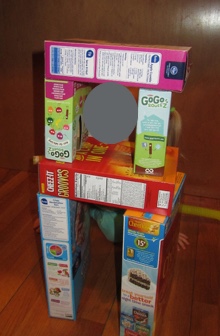
Figure 34. A house made from cereal boxes.
Figure 34 shows a house that a child has built using boxes. Two children stacked boxes to make them look like a house.

Figure 35. A child building a wall out of cereal boxes.
Figure 35 shows how a child made a wall using boxes. The direction I gave her was, "Let's make a wall. Let's see how many boxes you can stack to make a wall.” Notice the concentration and the different physical activities she’s doing to build her wall with boxes. She’s squatting on her stomach, propped up on her knees, standing, and standing on her tiptoes.
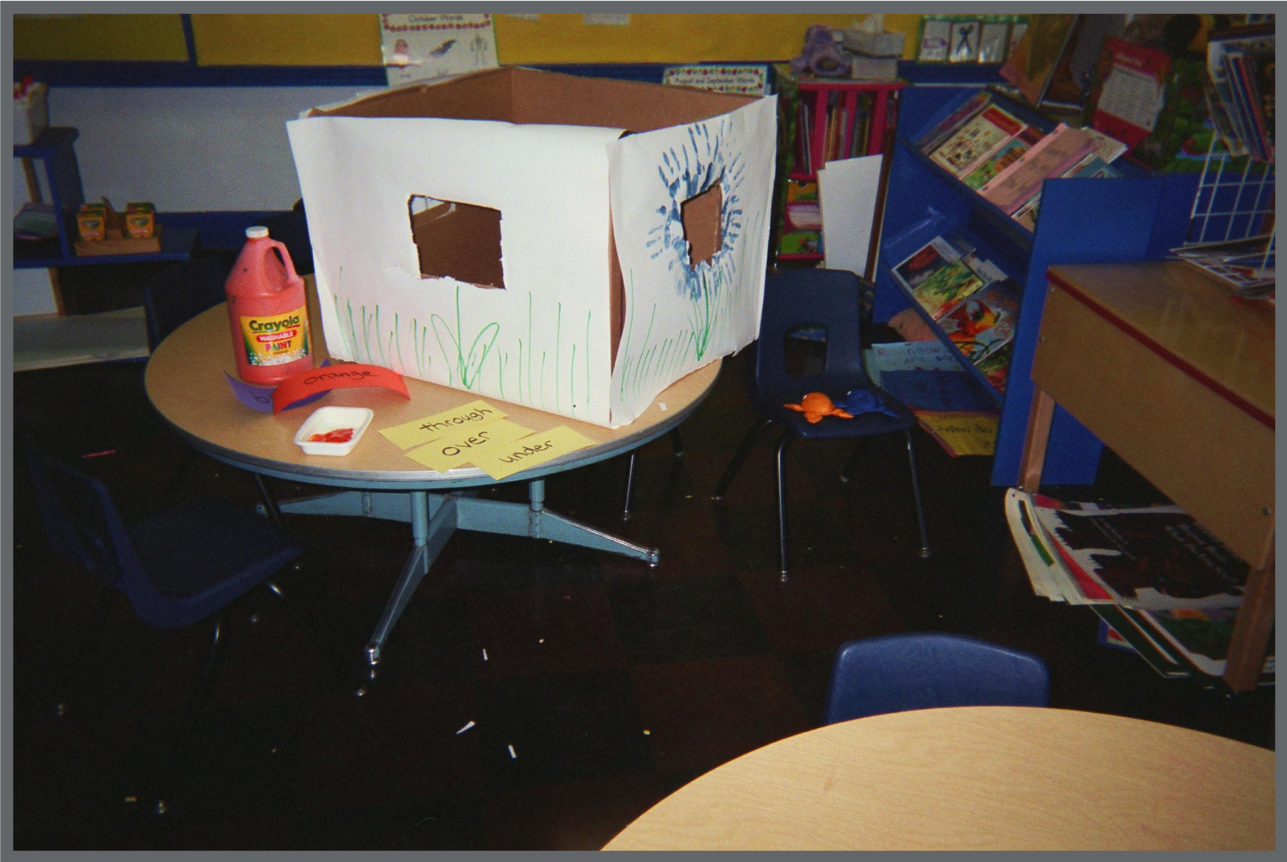
Figure 36. A recycled box decorated for a bean bag toss.
Figure 36 shows a larger box with holes cut in it placed on a table to do a bean bag toss. If you cover the box with paper, the box can be decorated by theme, either by you or the children. This also makes it easy to change the look of the box for various seasons or themes. For example, if you’re doing a garden theme color it like a flower garden. Then have the children put the bean bags through the flower, over the flower, and under the flower garden (table). Instead of bean bags, the children could place recycling supplies in the box. The box could be made into a garage if you’re doing a transportation unit and the children could put different transportation vehicles in, under, and over the box. This is just another way that you can use a box for practicing spatial concepts as well as for storing and building.
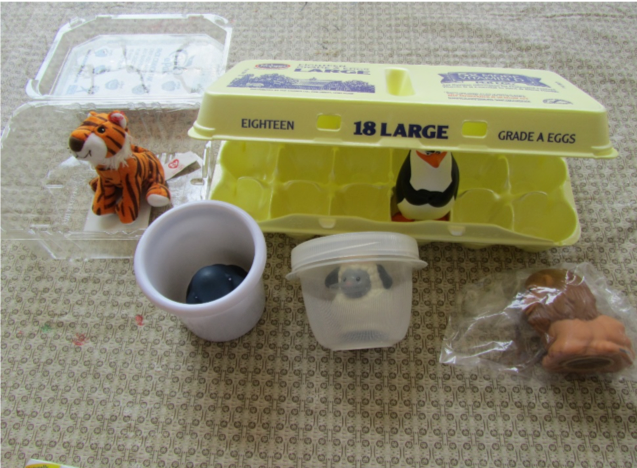
Figure 37. Recycled materials as animal cages for an animal zoo.
Little containers are great to save as well for sorting activities, whether it's egg cartons, different things that fruits and vegetables come in, applesauce or pudding containers, or Ziploc bags. I have a container that twists open, which encourages the use of fine motor skills. Figure 37 shows some of these containers used as animal cages for small toys. You could use several of them to make an animal zoo. It's great for storing little transportation vehicles such as cars, trains, or helicopters, and sorting different items as well. You can make these both gross motor and fine motor activities for the whole group and tabletop tasks based on the size of the box.

Figure 38. Homemade dice from a tissue box.
Figure 38 shows an example of how I made that dice I referred to earlier. To make a homemade dice you’ll need a tissue box. Fill it with crumpled up recycled paper. This could be pieces of newspaper, magazine pages, or scrap paper. This gives the box more durability. Then take a piece of cardboard and put it over the open side where you filled the box with paper so you have cardboard on all sides of the box. I seal it with some tape, but you can see in figure 33 the child is doing that herself. The children can all make their own box and take it home to their families. You can put anything you want on the sides, from physical activities to do, numbers, letters, or pictures of items in your theme.
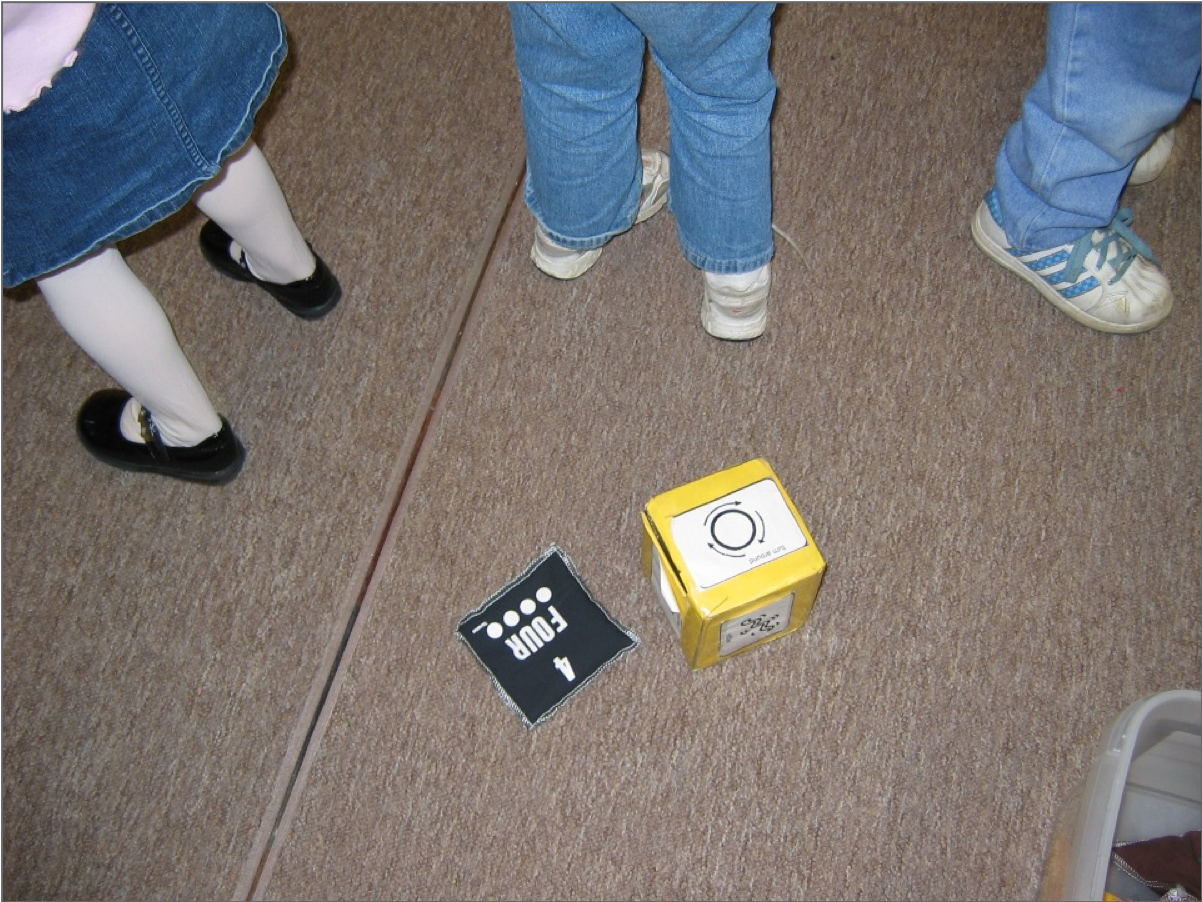
Figure 39. Homemade dice with numbers and actions.
If you put packaging tape around it, then you can easily take off and change out different types of physical activities, numbers, letters, colors, or the student's names with some tape or Velcro dots. Figure 39 shows one dice with the number four and the other dice shows they have to turn around four times. If you just have one dice they might roll a six and they have to clap six times.
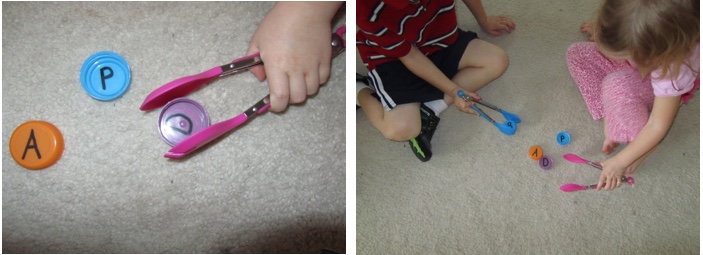
Figure 40. Using tongs to pick up caps.
Earlier I talked about putting different academic concepts in the bottle caps. This allows them to be used for sorting and patterning, but also for using fine motor skills to pick them up using different types of fine motor gadgets such as tongs as seen in figure 40.

Figure 41. Putting caps through slots in recycled containers.
Figure 41 shows how you can sort the bottle caps and put them into slots in different containers. You can make this both a gross and fine motor task by putting one container on a table to stand and fill and one on the floor for them to squat and fill.
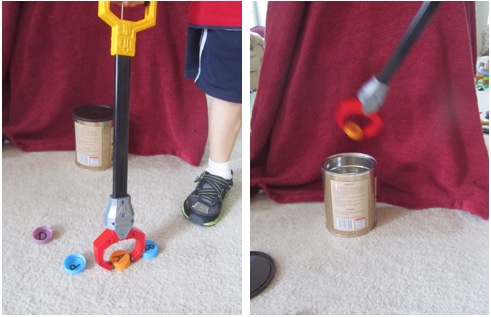
Figure 42. Using a tool to pick up bottle caps and place them in recycled containers.
Figure 42 shows a child using a different type of tool to get different bottle caps in different containers.
I hope all of you feel empowered and engaged and ready to go back to your class with practical suggestions and activities that you can turn right around and implement very quickly on a low-budget, with little space, and little planning time. If you have any further questions feel free to email me. My email is in the handout. I hope you leave today never looking at another recycling supply or another package again the same because you never know what kind of fun activity you will make out of this, and more importantly, you'll never know what kind of fun activities the kids are going to come up with as well with all of these recycling supplies.
References
See handout.
Citation
Schlessman, A. (2018). Recycle Bin Boogie – Move and Learn with Recyclables! continued.com – Early Childhood Education, Article 23139. Retrieved from www.continued.com/early-childhood-education
